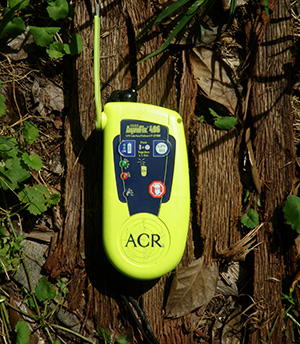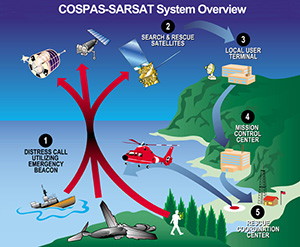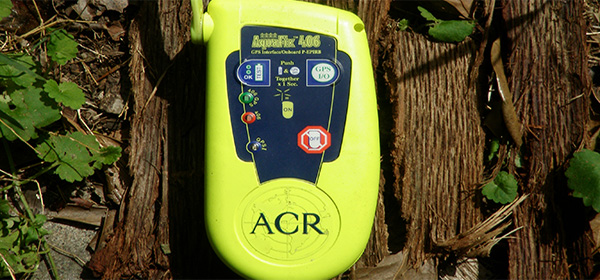It seems that every year I see one or more stories on the evening news and on the Web about someone who has ventured into the wilderness for recreational purposes but ends up becoming incapacitated due to an injury or lost because they have wondered off of the trail without sufficient training to find their way back. However, most of these cases could easily have been prevented if those people had chosen to purchase and carry a simple electronic device that is not much bigger than a smart phone known as a Personal Locator Beacon or P.L.B.
These simple devices enable the user to broadcast an electronic distress call almost anywhere on the planet by simply deploying the built-in antenna and then depressing two buttons simultaneously which then causes the device to send out a signal that alerts rescuers that they are in peril and are in need of assistance. Therefore, a Personal Locator Beacon can be thought of as a relatively inexpensive electronic insurance policy and, in the event that you ever need it, you will undoubtedly consider it a wise investment that was worth every penny!
Types of Personal Locator Beacons

Also, you should be aware that these devices are available in two different varieties and are available from several different manufactures such as Garmin, ACR, and McMurdo. Of course, the main difference between the two different types of P.L.B.’s is that one type transmits an S.O.S. signal only while the other type transmits your exact longitude and latitude along with your S.O.S. signal via a built-in G.P.S. transceiver. For you information, all personal locator beacons operate using a general locater 406 MHz radio frequency which is transmitted to the worldwide, non-geostationary, COSPASS-SARSAT International Satellite Rescue System as well as to any passing military or commercial aircraft which are all required to monitor emergency frequencies whenever they are airborne. In addition, they also transmit a 121.5 MHz homing signal that helps rescuers locate your exact position once they are on the scene. Plus, if you decide to spend a little extra to purchase one with a built-in G.P.S. transceiver, when you activate the unit, your G.P.S. coordinates are also transmitted along with both the general locator and homing signals. Therefore, usually within one hour, your S.O.S. signal, along with your G.P.S. coordinates, are forwarded through the system to the nearest rescue agency and a rescue team is dispatched to your location by local authorities.
Related: Finding Shelter in the Wild
Furtherm ore, in an effort to reduce the number of false S.O.S. signals transmitted by accidentally activated P.L.B.’s each year, all of these devices transmitting on the 406 MHz frequency include a 15, 22, or 30 character serial number called a “Hex Code” which you are required to register with the appropriate agency upon purchasing your Personal Locator Beacon and your registration must be updated each year. In addition, you are required to include certain information along with the registration of your “hex code” such as your name, a phone number that the rescuing agency can call to verify that there actually is an emergency, a description of the owner, and any other information that may useful to the rescuing agency so that they can identify you once they are on the scene. However, even if you do decide to purchase a Personal Locator Beacon with a built-in G.P.S. transceiver, rescue personnel may still have a difficult time locating your exact position if you are located in rough terrain and/or dense foliage. Therefore, it is also a wise idea to carry a coach’s whistle with you in addition to your Personal Locator Beacon in case you are incapacitated in an area of low visibility since, even with a G.P.S. transceiver installed, P.L.B.’s are only capable of transmitting your exact location to within 50 meters due to a margin of error purposely introduced into the system in order to prevent terrorists from using the system to guide smart bombs. Thus, a long, loud, toot on your whistle, repeated frequently, with a pause in between each toot will help rescuers to home in on your exact position once they arrive on the scene.
ore, in an effort to reduce the number of false S.O.S. signals transmitted by accidentally activated P.L.B.’s each year, all of these devices transmitting on the 406 MHz frequency include a 15, 22, or 30 character serial number called a “Hex Code” which you are required to register with the appropriate agency upon purchasing your Personal Locator Beacon and your registration must be updated each year. In addition, you are required to include certain information along with the registration of your “hex code” such as your name, a phone number that the rescuing agency can call to verify that there actually is an emergency, a description of the owner, and any other information that may useful to the rescuing agency so that they can identify you once they are on the scene. However, even if you do decide to purchase a Personal Locator Beacon with a built-in G.P.S. transceiver, rescue personnel may still have a difficult time locating your exact position if you are located in rough terrain and/or dense foliage. Therefore, it is also a wise idea to carry a coach’s whistle with you in addition to your Personal Locator Beacon in case you are incapacitated in an area of low visibility since, even with a G.P.S. transceiver installed, P.L.B.’s are only capable of transmitting your exact location to within 50 meters due to a margin of error purposely introduced into the system in order to prevent terrorists from using the system to guide smart bombs. Thus, a long, loud, toot on your whistle, repeated frequently, with a pause in between each toot will help rescuers to home in on your exact position once they arrive on the scene.
Where To Purchase a Personal Locator Beacon
Last, it should be noted that these devices range in price from $299.00 to $499.00 MSRP for the McMurdo Fast Find and from $401.00 to $543.00 MSRP for the ACR SAR Link and Aqua Link P.L.B.’s. Also, each of these units is completely waterproof and they feature a tough, shockproof, polycarbonate, outer shell and a built-in antenna. In addition, they also feature a test function which allows you to test both the battery and the unit’s functionality without transmitting an S.O.S signal along with several other new, innovative, features. Plus, they are extremely simple to operate since all you have to do is depress two buttons simultaneously and an S.O.S. signal along with your GPS coordinates will be transmitted to any passing COSPASS-SARSAT satellites after a short delay of about 60 seconds to allow you to turn of the unit off in the event that you accidently activate it. Last, each of these units features an integral battery with a shelf life of up to six years that can be stored at temperatures ranging from -22° F to 158° F.
Consequently, although you will hopefully never need it, purchasing and carrying a Personal Locator Beacon is like having an inexpensive life insurance policy in your pocket. Plus, because they are small and lightweight, they are easy to carry and take up very little room. But, most importantly, on the one occasion that you really need it, you will thank yourself a thousand times over that you had to foresight to purchase this small, electronic, insurance policy and, your family will thank you as well since, simply by having one of these units with you, your chances of surviving a wilderness emergency situation will be drastically increased!
You may also like:
15 Lost Survival Tips From The Cowboys Who Wandered The West – With Illustrations
Lost Survival Tips From The Cowboys Who Wandered The West – With Illustrations
How To Turn Air into Water (Video)
5 Best Countries To Move To Before SHTF
5 Bad-ass Perimeter Defense Lessons From A Vietnam Vet

Bill Bernhardt is a professional outdoor/wildlife writer and is a professional fly fishing instructor and guide as well as a professional hunting guide. He is an avid outdoors-man with expertise in fly fishing, hunting, firearms, archery, cutlery, outdoor survival, camping, and kayak touring. If you liked this article and want to read more from Bill, check out his Amazon Author Page.















If you are going out by yourself into the outback this would be good to have,….but for a prepper? Did you think this thing through, or are you just interested in ,making money of your list?
However for me it looks more like a “COME SHOOT ME, I’M RIGHT HERE.” locator beacon.
Who is on the other end of this device? Who will hear it? Who will respond?
If things are so bad that I have to use my BOB, GOOD or E&E route system, then maybe I don’t want to be found and those that would be available in peaceful times to come get me will have their hands too full to respond anyway even if they have the equipment to do so.
H
Hi Moxi, As you can see, this article is about wilderness survival not preparedness in general. I think it’s better in a way to have a wide range of articles here.
This device also works well and isn’t just for emergencies. We purchased on while sailing in the Caribbean to let our children and others know our whereabouts at any given time and we also would send “We’ve arrived safely messages at the end of a passage.
http://www.findmespot.com/en/
Anytime someone says “you must have this” to me is a red flag. venturing in the woods for recreational purposes versus being a survivalist are 2 different things. I am not saying this device can’t be useful, but not necessity and definitley not a “Must have”. I have hunted and trapped on 3200 acress of land as a teenager and never had this or a cellphone, or a radio and survived just fine. matter of fact, the less beeping & flashing devices you carry, the better off you are in Wilderness. Good map & compass skills,and know your limitations will work just fine. People become to dependent on gadgets and when they fail they are worse off. As a ham radio operator & having been on a volunteer search & rescue team for 10 years, depending on satellites to receive the signals or gps isn’t always reliable. this may work better on open sea, but in wilderness & woods or high hills can be a problem. spend your money on good compass and maps for wilderness and take time to learn the area.
Totally agree! Electronics are man-made and so can and do fail, we need to be able to read flat maps, a must!
This is exactly what David Paulides advised when venturing into National Parks. Missing 411 is some good reading